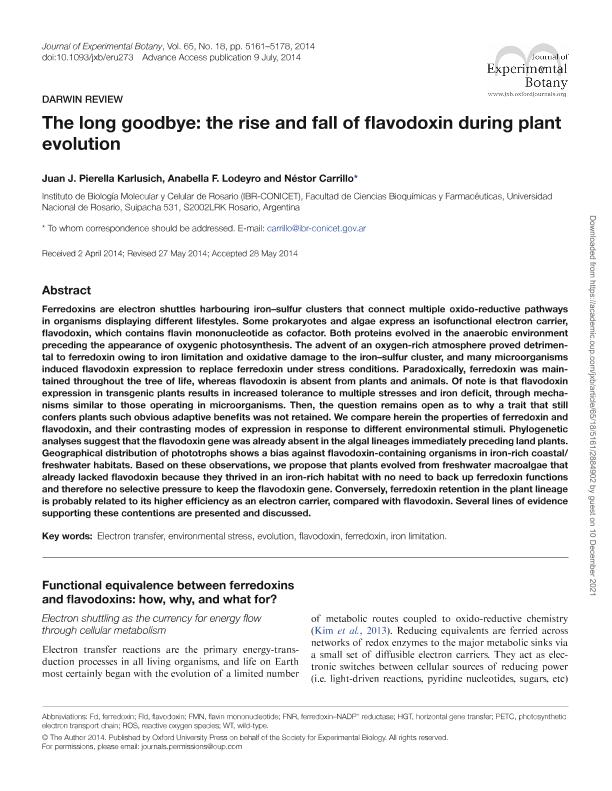Mostrar el registro sencillo del ítem
dc.contributor.author
Pierella Karlusich, Juan José

dc.contributor.author
Lodeyro, Anabella Fernanda

dc.contributor.author
Carrillo, Nestor Jose

dc.date.available
2017-07-26T19:15:02Z
dc.date.issued
2014-07
dc.identifier.citation
Pierella Karlusich, Juan José; Lodeyro, Anabella Fernanda; Carrillo, Nestor Jose; The long goodbye: the rise and fall of flavodoxin during plant evolution; Oxford University Press; Journal Of Experimental Botany; 65; 18; 7-2014; 5161-5178
dc.identifier.issn
0022-0957
dc.identifier.uri
http://hdl.handle.net/11336/21361
dc.description.abstract
Ferredoxins are electron shuttles harbouring iron–sulfur clusters that connect multiple oxido-reductive pathways in organisms displaying different lifestyles. Some prokaryotes and algae express an isofunctional electron carrier, flavodoxin, which contains flavin mononucleotide as cofactor. Both proteins evolved in the anaerobic environment preceding the appearance of oxygenic photosynthesis. The advent of an oxygen-rich atmosphere proved detrimental to ferredoxin owing to iron limitation and oxidative damage to the iron–sulfur cluster, and many microorganisms induced flavodoxin expression to replace ferredoxin under stress conditions. Paradoxically, ferredoxin was maintained throughout the tree of life, whereas flavodoxin is absent from plants and animals. Of note is that flavodoxin expression in transgenic plants results in increased tolerance to multiple stresses and iron deficit, through mechanisms similar to those operating in microorganisms. Then, the question remains open as to why a trait that still confers plants such obvious adaptive benefits was not retained. We compare herein the properties of ferredoxin and flavodoxin, and their contrasting modes of expression in response to different environmental stimuli. Phylogenetic analyses suggest that the flavodoxin gene was already absent in the algal lineages immediately preceding land plants. Geographical distribution of phototrophs shows a bias against flavodoxin-containing organisms in iron-rich coastal/freshwater habitats. Based on these observations, we propose that plants evolved from freshwater macroalgae that already lacked flavodoxin because they thrived in an iron-rich habitat with no need to back up ferredoxin functions and therefore no selective pressure to keep the flavodoxin gene. Conversely, ferredoxin retention in the plant lineage is probably related to its higher efficiency as an electron carrier, compared with flavodoxin. Several lines of evidence supporting these contentions are presented and discussed.
dc.format
application/pdf
dc.language.iso
eng
dc.publisher
Oxford University Press

dc.rights
info:eu-repo/semantics/openAccess
dc.rights.uri
https://creativecommons.org/licenses/by-nc-sa/2.5/ar/
dc.subject
Electron Transfer
dc.subject
Environmental Stress
dc.subject
Evolution
dc.subject
Flavodoxin
dc.subject.classification
Bioquímica y Biología Molecular

dc.subject.classification
Ciencias Biológicas

dc.subject.classification
CIENCIAS NATURALES Y EXACTAS

dc.title
The long goodbye: the rise and fall of flavodoxin during plant evolution
dc.type
info:eu-repo/semantics/article
dc.type
info:ar-repo/semantics/artículo
dc.type
info:eu-repo/semantics/publishedVersion
dc.date.updated
2016-11-24T19:36:25Z
dc.identifier.eissn
1460-2431
dc.journal.volume
65
dc.journal.number
18
dc.journal.pagination
5161-5178
dc.journal.pais
Reino Unido

dc.journal.ciudad
Oxford
dc.description.fil
Fil: Pierella Karlusich, Juan José. Consejo Nacional de Investigaciones Científicas y Técnicas. Centro Científico Tecnológico Conicet - Rosario. Instituto de Biología Molecular y Celular de Rosario. Universidad Nacional de Rosario. Facultad de Ciencias Bioquímicas y Farmacéuticas. Instituto de Biología Molecular y Celular de Rosario; Argentina
dc.description.fil
Fil: Lodeyro, Anabella Fernanda. Consejo Nacional de Investigaciones Científicas y Técnicas. Centro Científico Tecnológico Conicet - Rosario. Instituto de Biología Molecular y Celular de Rosario. Universidad Nacional de Rosario. Facultad de Ciencias Bioquímicas y Farmacéuticas. Instituto de Biología Molecular y Celular de Rosario; Argentina
dc.description.fil
Fil: Carrillo, Nestor Jose. Consejo Nacional de Investigaciones Científicas y Técnicas. Centro Científico Tecnológico Conicet - Rosario. Instituto de Biología Molecular y Celular de Rosario. Universidad Nacional de Rosario. Facultad de Ciencias Bioquímicas y Farmacéuticas. Instituto de Biología Molecular y Celular de Rosario; Argentina
dc.journal.title
Journal Of Experimental Botany

dc.relation.alternativeid
info:eu-repo/semantics/altIdentifier/doi/http://dx.doi.org/10.1093/jxb/eru273
dc.relation.alternativeid
info:eu-repo/semantics/altIdentifier/url/https://academic.oup.com/jxb/article/65/18/5161/2884902/The-long-goodbye-the-rise-and-fall-of-flavodoxin
dc.relation.alternativeid
info:eu-repo/semantics/altIdentifier/url/https://www.ncbi.nlm.nih.gov/pmc/articles/PMC4400536/
Archivos asociados
